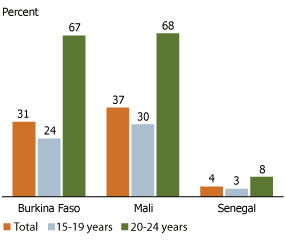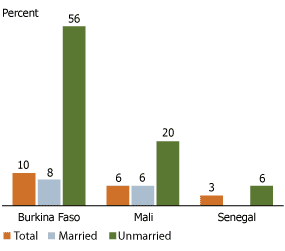
Sexual Behavior and Contraceptive Use Among Youth in West Africa
Date
February 19, 2009
Author
Youth around the world—especially young women—experience a high risk of unplanned pregnancy and HIV because of their limited knowledge about sexual and reproductive health. Sexual behaviors among youth can include positive practices, such as abstinence and condom use, or lead to negative outcomes such as unplanned pregnancy and the spread of sexually transmitted infections (STIs). Knowledge of contraceptives and contraceptive use are important indicators of sexual health among youth. Sexual behaviors and contraceptive use among youth not only vary across countries and regions, but vary within a given country as well. This article examines data from the Demographic and Health Surveys (DHS) conducted in three Francophone West African countries: Burkina Faso, Mali, and Senegal, and explores the variation in sexual knowledge and practice among youth ages 15 to 24 in these countries. With this information, policymakers and program managers can develop programs that more effectively respond to the sexual and reproductive health needs of youth.
Sexual Behaviors of Youth
A first step in reducing the risk of negative outcomes among young women is understanding their sexual behavior. Levels of sexual activity among young unmarried women were similar in Mali and Burkina Faso, but the experience reported by young Senegalese women was very different (see Figure 1). In Mali and Burkina Faso, 30 percent to 40 percent of young unmarried women reported that they had been sexually active. In contrast, only 4 percent of unmarried young women in Senegal indicated that they had ever had sex, making it one of the lowest levels in sub-Saharan Africa. The median age at first sexual intercourse was lowest for women in Mali at 15.9 years followed by 17.5 years in Burkina Faso; in Senegal the median age at first sexual intercourse was among the highest in sub-Saharan countries at 19.6 years. As expected, sexual experience increases with age. In Burkina Faso and Mali, women ages 20 to 24 were more likely to have had sex (67 percent and 68 percent, respectively), but in Senegal, levels of sexual activity even among the 20 to 24-year-olds was quite low, at only 8 percent.
Figure 1
Percentage of Never-Married Women Ages 15-24 Reporting Sexual Activity

Source: Shane Khan and Vinod Mishra, DHS Comparative Reports No. 19, Youth Reproductive and Sexual Health
Specific factors such as education, place of residence, and wealth group are often associated with higher levels of sexual activity. In Burkina Faso and Mali, the percentage of women who reported sexual activity increased with higher levels of education, urban residence, and family wealth. However, in Senegal, according to the DHS, none of these three factors has much effect on sexual activity. For example, regardless of education level, only 4 percent of unmarried Senegalese women between ages 15 and 24 reported that they had ever been sexually active. In contrast, young unmarried women with higher education levels in Burkina Faso were almost twice as likely ever to have had sex as young unmarried women who never attended school (45 percent vs. 24 percent). Similarly in Burkina Faso, twice as many young women from the wealthiest group reported ever having sex as young women in the poorest group.
Youth Contraceptive Use
Among sexually active youth, contraceptive use reduces the number of unplanned pregnancies. However, before using a contraceptive, youth must first have knowledge of different methods. In Senegal and Burkina Faso, more than 85 percent of young women surveyed knew at least one form of modern contraception, but far fewer (67 percent and 66 percent, respectively) knew three or more modern methods. Knowledge in Senegal was lower, with only 76 percent of young women knowing one method and only 56 percent having knowledge of three or more.
Given the relatively high levels of knowledge of contraceptives among young women, use of contraceptives is relatively low among married women, but higher among sexually active unmarried women. In Burkina Faso, only 8 percent of married young women use modern contraception; in contrast, 56 percent of unmarried sexually active young women use modern contraception. Prevalence among both groups of young women in Mali was lower: 6 percent among married young women and 20 percent among unmarried young women. In Senegal, 6 percent of young married women use a family planning method, but the number of sexually active unmarried women was so low that the survey did not estimate a prevalence rate. In all three countries, the number of unmarried sexually active young women was quite small, so although their contraceptive use may be higher, they represent a very small percentage of young women.
Figure 2
Modern Contraceptive Use Among Women Ages 15-24 (Percent)

Source: Shane Khan and Vinod Mishra, DHS Comparative Reports No. 19, Youth Reproductive and Sexual Health
Living in an urban area is associated with contraceptive use for young married women in all three countries. The largest difference was noted in Burkina Faso, where 31 percent of young married women in urban areas used contraceptives compared with only 4 percent in rural areas. Level of education was also associated with higher use of modern contraceptives among young married women. In all three countries, young married women who had a secondary education were much more likely—as much as three times more likely—to use modern contraception than women with only a primary education. Similarly, married young women in the highest wealth status quintile reported higher levels of modern contraceptive use (14 percent to 28 percent), compared with the poorest group, where prevalence was only 1 percent to 2 percent.
Program Efforts to Serve Young Adults
In recent years, a number of efforts have been made in all three countries to assist young people with a better understanding of sexual and reproductive health and improve access to family planning services. Since much of the population lives in rural areas, efforts to reach youth can be challenging. However, young people represent a large percentage of the population and, without access to information and services, are at risk of negative outcomes.
In Burkina Faso, for example, a National Adolescent Reproductive Health Program was launched in 1995. Information efforts have worked to raise awareness of HIV/AIDS, gender-based violence, and improve the quality of health care services. Other efforts have included youth centers that provide family planning education, counseling, and peer education. Another program has trained teachers on sex education and population issues. A number of efforts have focused on raising awareness among youth on HIV/AIDS prevention.1
Similar efforts in Mali have focused on reaching young adults. Effort to train peer educators and young leaders in sexual and reproductive health have contributed to increased use of contraceptives among young adults in program areas. A peer educator program trained 2,000 volunteers that reached more than 630,000 young people ages 10 to 24.2
Programs in Senegal have worked at both the policy level and in direct services to youth. Successful efforts by advocates have led to incorporating adolescent reproductive health within the Ministry of Health and the Ministries of Education, Sports, and Youth. Programs have included curricula for peer educators, training for teachers, and the development of norms and guidelines in reproductive health for adolescents.3
Understanding youth sexual behaviors and contraceptive use can help improve policies addressing reproductive health knowledge and behavior among young women in countries such as Burkina Faso, Mali, and Senegal. Increased knowledge can empower young women to have more control over their reproductive health and access family planning resources where needs are not being met. Improvements in sexual health behavior and knowledge among youth can lead to a decrease in the spread of STIs including HIV infection as well as fewer unplanned pregnancies, which will allow for a healthier generation of families.
Grace Dann is an intern with International Programs at PRB.
References
- The Allen Guttmacher Institute, Adolescents in Burkina Faso: Sexual and Reproductive Health, Research in Brief Series, No. 3, accessed online at www.guttmacher.org, on Feb. 13, 2009.
- Elizabeth T. Robinson, “Programs for Adolescents: Neighborhood Peer Educators in Mali,” Network 20, no. 3 (2000), accessed online at www.fhi.org, on Feb. 11, 2009.
- Nafissatou Diop and Anta Fall Diagne, “Mainstreaming Adolescent Health in Senegal: Enhancing Utilization of the Findings from the Youth Reproductive Health Project,” FRONTIERS Report (Dakar: Population Council, 2007), accessed online at www.pcdc.org, on Feb. 11, 2009; and The Centre for Development and Population Activities, Reproductive Health for Youth in Mali Project: End of Project Report, (Washington, DC: The Centre for Development and Population Activities, 2003), accessed online at www.cedpa.org, on Feb. 11, 2009.
